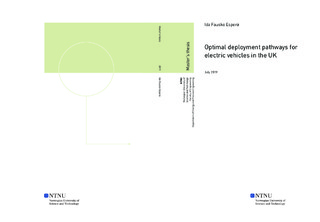| dc.contributor.advisor | Strømman, Anders Hammer | |
| dc.contributor.advisor | Hung, Christine | |
| dc.contributor.author | Esperø, Ida Fausko | |
| dc.date.accessioned | 2019-11-01T15:00:23Z | |
| dc.date.available | 2019-11-01T15:00:23Z | |
| dc.date.issued | 2019 | |
| dc.identifier.uri | http://hdl.handle.net/11250/2626170 | |
| dc.description.abstract | Storbritannia har forpliktet seg til å redusere sine klimagassutslipp med 80 % i 2050, relativt til 1990. I 2018 stod veitrafikken for en tredjedel av de nasjonal utslippene, så en avkarbonisering av denne sektoren har et stort potensiale for å bidra til at Storbritannia når sine klimamål. Storskala innføring av elektriske biler er per i dag et av de mest lovende tiltakene som kan bidra til dette. Sammenliknet med en konvensjonell bil som kjører på diesel, har elbilen lavere utslipp gjennom hele livsløpet hvis den er ladet med elektrisitet fra fornybare kilder.
Målet med denne oppgaven er å vurdere den optimale timingen for elektrifiseringen av Storbritannias bilflåte, og som en del av dette, finne kombinasjonen av elektriske og konvensjonelle biler som minimerer de totale klimagassutslippene fra flåten mellom 2020 og 2050. Storskala innføring av elbiler må sees i sammenheng med en potensiell avkarbonisering av elektrisiteten som brukes til ladning av bilen. Timingen er derfor viktig fordi karbonbudsjettet vi har til gode for å utvikle samfunnet vårt er begrenset. For å oppnå målet med oppgaven er det benyttet en optimeringsmodell, hvor denne er kombinert med data fra livssyklusanalyser og statistikk.
Gjennom oppgaven er det funnet at en innføring av elbiler i Storbritannia er fordelaktig med tanke på å redusere klimapåvirkningen fra transportsektoren. Det er også funnet at elektrisitetsmiksen i Storbritannia per i dag er ren nok til at til at en elbil har lavere livsløpsutslipp enn en dieselbil, også selv om elektrisiteten ikke kun kommer fra fornybare kilder. Den optimale løsningen vil derfor være en storskala innføring av elbiler så fort som mulig, noe som da må legges til rette for av myndighetene.
På kort sikt, noe som vil si det neste tiåret, vil en storskala innføring av elbiler føre til høyere årlige utslipp på grunn av at en elbil har høyere produksjonsutslipp enn en dieselbil. I de resterende årene vil innføringen av elbiler føre til en reduksjon av de årlige utslippene fra bilflåten, sammenliknet med en fossil bilflåte. I 2050 vil de årlige direkte utslippene fra bilflåten være redusert med 92 % sammenliknet med utslippene i 2017 fra nasjonale databaser, gitt at innføringen av elbiler skjer i henhold til det som er modellert i hovedscenarioet i oppgaven, og karbonintensiteten til elektrisiteten reduseres markant. | |
| dc.description.abstract | Through the Climate Change Act, the UK has committed to reducing the annual emissions by 80 % relative to 1990 levels. In 2018, road transport was accountable for one-third of the national carbon dioxide emissions. Thus, a decarbonization of this sector has great potential to contribute to the national emission reduction. Battery-electric vehicles (BEVs) are currently one of the most promising technologies that can contribute to this. Compared to an internal combustion engine vehicle (ICEV) running on diesel, the BEV has shown to have lower life cycle emissions if operated on low-carbon electricity.
The objective of this thesis is to assess the optimal timing for electrifying the passenger car fleet in the UK. This implies finding the combination of BEVs and ICEVs that minimize the total greenhouse gas emissions from the fleet between 2020 and 2050, subject to given constraints. The insight is that the timing of the introduction should be seen together with future decarbonization of the electricity sector and other potential technological improvements in the vehicle technologies. Addressing the timing is necessary since the carbon budget for transitioning our society is constrained. The goal of the thesis will be achieved by applying an optimization model combined with data from life cycle assessments (LCA) and statistical databases.
Through this thesis it was shown that the deployment of BEVs in the UK is beneficial in terms of mitigating climate change, even though the electricity mix is not yet fully renewable. Since the UK electricity mix is by now clean enough for BEVs to be environmentally superior to the ICEVs, the optimal solution would be to deploy the BEVs as fast as possible. From the scenario analysis it was, however, clear that the mitigation potential is reduced if the deployment of electric vehicles are delayed or the UK fails to decarbonize the power sector.
In the short-term, meaning the next decade, it was found that the deployment of BEVs led to an increase in the annual fleet emissions, due to the higher embodied emissions in the BEV production phase. In the remaining years towards 2050, the large scale BEV deployment will contribute to reducing the annual emissions compared to a fleet of only ICEVs. In 2050, the annual direct emissions from the fleet will be reduced by 92 %, relative to 2017 levels, if the BEV deployment rate follows the path as in the main scenario and the UK successfully implements low-carbon energy sources. | |
| dc.language | eng | |
| dc.publisher | NTNU | |
| dc.title | Optimal deployment pathways for electric vehicles in the UK | |
| dc.type | Master thesis | |
